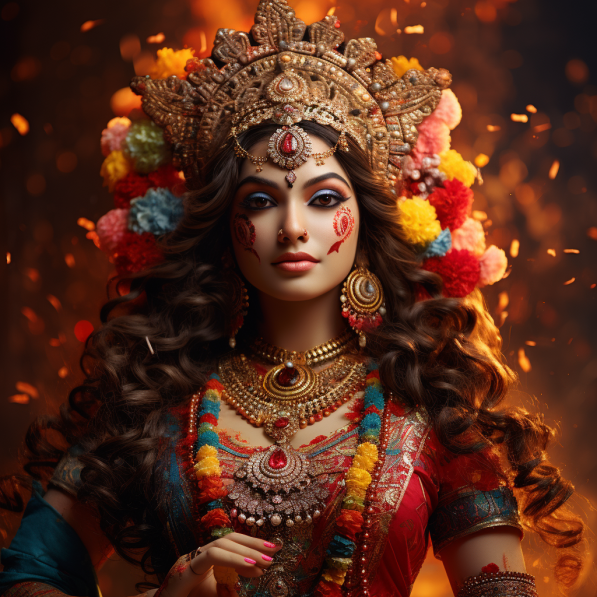Dive into the vibrant world of Navratri colours and uncover their spiritual significance in this detailed guide. Embrace the celebration of hues and traditions!
Navratri, one of India’s most vivacious festivals, is a symphony of faith, devotion, and colour. These nine auspicious nights, dedicated to Goddess Durga, take us on a transcendental journey, highlighting the essence of Shakti – the female power. While the festival brings a spiritual awakening for many, it also paints the towns and cities with a vibrant spectrum of colours. Each day has its significance, denoted by a unique hue, making Navratri not just a spiritual retreat but also a celebration of the myriad hues of life.
The cultural and geographical diversity of India means that the festival is celebrated in varied ways, with dances, fasting, prayers, and, of course, the nine revered colours. For many, deciding what colour to wear on each day has become an exciting tradition. Yet, beyond the surface-level enthusiasm of dressing up, lies a deeper understanding and appreciation of why these specific colours were chosen for these particular days.
In the realms of ancient scriptures and traditions, colours have always held symbolic meanings. They serve as non-verbal expressions of emotions, beliefs, and stories. Navratri colours are no exception. Every shade that’s worn during these nine days represents a facet of the Goddess Durga, a narrative from the epics, or an attribute we aspire to imbibe.
While it’s easy to get lost in the festivities and the dazzle of lights, taking a moment to understand the true essence of these colours can make the Navratri experience more enriching. Knowing the significance not only enhances our understanding of this grand celebration but also makes us appreciate the wisdom and depth of our age-old traditions.
Join us as we delve into the vibrant world of Navratri colours, exploring the legends, stories, and symbolism behind each one. Let’s discover how these colours weave the fabric of our faith, traditions, and collective consciousness.
The Nine Colours of Navratri and Their Significance
- Royal Blue (Day 1): The first day of Navratri is dedicated to Shailaputri, the first form of Goddess Durga. Royal blue stands for calm yet powerful energy. Wearing this colour on the first day symbolizes the quest for tranquillity and a strong, undeterred mind, setting the right tone for the days to come.
- Yellow (Day 2): Representing the bright and lively spirit of nature, yellow is worn on the second day. This day is dedicated to Goddess Brahmacharini, the one who embodies penance. The sunny hue signifies happiness, positivity, and a radiant spirit.
- Green (Day 3): Dedicated to Chandraghanta, the third form of the Goddess, green symbolizes growth, prosperity, and peace. Wearing this colour on the third day is a reflection of one’s aspirations for harmony and spiritual growth.
- Grey (Day 4): Representing Goddess Kushmanda, grey is a symbol of the strength to transform the dull into the vibrant. It signifies the power of vulnerability and the ability to turn weakness into strength.
- Orange (Day 5): Symbolizing energy and happiness, orange is worn on the fifth day dedicated to Skandamata, the mother of Skanda (Lord Kartikeya). This vibrant colour represents enthusiasm, creativity, and the spirit of adventure.
- White (Day 6): This day is dedicated to Katyayani, the fierce form of Durga. White represents peace, purity, and innocence. Wearing this colour signifies a prayer for protection and a quest for clarity and wisdom.
- Red (Day 7): Representing Goddess Kalaratri, red is the colour of action, vigour, and warmth. It embodies the fiery aspect of Durga, signifying passion, power, and determination.
- Sky Blue (Day 8): Dedicated to Mahagauri, the eighth form of Durga, sky blue represents aspirations, dreams, and the infinite possibilities of the universe. It signifies hope and the boundless skies.
- Pink (Day 9): The final day, dedicated to Siddhidatri, the provider of supernatural powers, pink is a symbol of optimism, love, and compassion. It captures the essence of universal love and the hope for a brighter tomorrow.
Conclusion
The vivacious colours of Navratri are not just an aesthetic delight but a reflection of our rich cultural and spiritual tapestry. They teach us that life, like the spectrum of colours, is a mix of various experiences, emotions, and learnings. Each colour, with its distinct significance, encourages us to embrace different facets of our being and the world around us.
In today’s fast-paced world, traditions like these anchor us, providing a sense of belonging and continuity. The Navratri colours, with their profound meanings, remind us to celebrate diversity, embrace change, and seek growth. They’re a beacon of hope, faith, and the unyielding spirit of humanity.
As we dance to the beats of Garba and immerse ourselves in prayers, let’s also take a moment to internalize the lessons these colours bring. After all, the true essence of Navratri lies not just in external celebrations but in the inner journey of self-awareness, understanding, and spiritual enlightenment.
In the end, Navratri is a reminder that amidst the changing seasons of life, there is an unchanging essence, a perpetual flame, that burns bright within each one of us, guiding, nurturing, and illuminating our path.
Follow Startup Theater on Instagram for valuable content on entrepreneurship
If you’re a startup founder, submit your startup story for free with us
Did you know? Startups like to use our coworking space in Bangalore
Call +917090977222 to reserve your space at Work Theater
Learn more about our coworking space on our YouTube channel Work Theater Studios where we talk about a variety of topics including personal finance, entrepreneurship, business and life.




